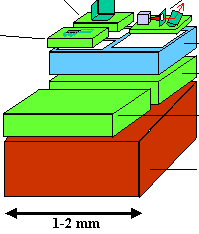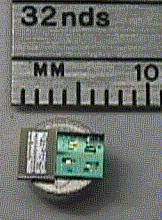SMART DUST
Autonomous sensing and communication in a cubic millimeter
PI: Kris Pister
Co-investigators: Joe Kahn,
Bernhard
Boser
Subcontract: Steve Morris, MLB
Co.
Supported by the DARPA/MTO MEMS
program
This project finished in 2001, but many additional projects have grown
out of it. Among these are
If you are interested in commercial applications, you should check out Crossbow
Technologies and Dust Networks. (N.b. I have a financial interest in both!)
Quick progress
update. Another update.
29 Palms
demo of air-emplaced 1" scale motes detecting vehicles.
Latest photos
and press coverage.
My view of sensor
networks in 2010.


The two figures above represent where we are and where we'd like to
be.
On the left is where we hope to be in July of '01 - a cubic millimeter
device with a sensor, power supply, analog circuitry, bidirectional optical
communication, and a programmable microprocessor. Click on the figure
to get more detail.
On the right is where we are now (July '99) - a (currently) non-functional
mote with a volume of about 100 cubic millimeters. There are two
silicon chips sitting on a type-5 hearing aid battery. The right
chip is a MEMS corner cube optical transmitter array - it works.
On the right is a CMOS ASIC with an optical receiver, charge pump, and
simple digital controller - it doesn't work (we violated some of the design
rules in the 0.25 micron process, but the next one should work).
Projects
-
Laser communication from a cubic millimeter
-
Mote Delivery
-
Sub-microWatt Electronics
-
Power Sources
-
Macro
Motes (COTS Dust)
Accomplishments
-
Using commercial-off-the-shelf (COTS) components, we've built some really
wonderful little "macro
motes". Some the features:
-
temperature, humidity, barometric pressure, light intensity, tilt and vibration,
and magnetic field sensors all in a cubic inch package, including the bi-directional
radio, the microprocessor controller, and the battery!
-
20 meter communication range
-
one week lifetime in continuous operation, 2 years with 1% duty cycling
-
21 km laser communication (Coit Tower and Twin Peaks in San Francisco to
Cory Hall at UC Berkeley)
-
Using one of the micro-weather stations, we stripped off the radio and
wired in a laser pointer. This went to SF. In my office at
Cal we had a video camera hooked up to a frame grabber in my laptop.
The software looked for (and decoded) flashing lights in the image, and
gave us the weather information 21 km away.
-
Large angle MEMS beam-steering
-
The laser motes above need to be aimed. We've made a sub-millimeter
mirror coupled to two motors on the same silicon chip. The motors
can scan a reflected laser beam tens of degrees in either direction.
-
Micro Air Vehicle endurance record
-
Sub-contractor Steve Morris of MLB Co has built an 8"
radio controlled plane which flys 60mph for 18 minutes and can carry
a color video camera with a live video feed.
-
Silicon maple seeds
-
Using a honeycombed layer of silicon only 0.1 mm thick we have made a 3x10
mm winglet. With a cubic millimeter of silicon attached, these wings
auto-rotate as they fall, just like a maple seed. The next generation
will have solar cells built right in. (ok this generation had the solar
cells too, but they didn't work!)
Applications
The science/engineering goal of the Smart Dust project is to demonstrate
that a complete sensor/communication system can be integrated into a cubic
millimeter package. This involves both evolutionary and revolutionary
advances in miniaturization, integration, and energy management.
We aren't targeting any particular sensor, in fact there is no direct funding
for sensor research in the project (but we've got quite a few to choose
from based on a decade or two of outstanding MEMS work at Berkeley and
elsewhere).
We're funded by DARPA, so we will demonstrate Smart Dust with one or
more applications of military relevance. In addition, we're pursuing
several different applications with commercial importance, and we've got
a long list of applications to work on if we only had the time. Here's
a sampling of some possible applications, in no particular order:
-
Defense-related sensor networks
-
battlefield surveillance, treaty monitoring, transportation monitoring,
scud hunting, ...
-
Virtual
keyboard
-
Glue a dust mote on each of your fingernails. Accelerometers will
sense the orientation and motion of each of your fingertips, and talk to
the computer in your watch. QWERTY is the first step to proving the
concept, but you can imagine much more useful and creative ways to interface
to your computer if it knows where your fingers are: sculpt 3D shapes in
virtual clay, play the piano, gesture in sign language and have to
computer translate, ...
-
Combined with a MEMS augmented-reality heads-up display, your entire computer
I/O would be invisible to the people around you. Couple that with
wireless access and you need never be bored in a meeting again! Surf
the web while the boss rambles on and on.
-
Inventory Control
-
The carton talks to the box, the box talks to the palette, the palette
talks to the truck, and the truck talks to the warehouse, and the truck
and the warehouse talk to the internet. Know where your products
are and what shape they're in any time, anywhere. Sort of like FedEx
tracking on steroids for all products in your production stream from raw
materials to delivered goods.
-
Product quality monitoring
-
temperature, humidity monitoring of meat, produce, dairy products
-
Mom, don't buy those Frosted Sugar Bombs, they sat in 80% humidity for
two days, they won't be crunchy!
-
impact, vibration, temp monitoring of consumer electronics
-
failure analysis and diagnostic information, e.g. monitoring vibration
of bearings for frequency signatures indicating imminent failure (back
up that hard drive now!)
-
Smart office spaces
-
The Center for the Built Environment
has fabulous plans for the office of the future in which environmental
conditions are tailored to the desires of every individual. Maybe
soon we'll all be wearing temperature, humidity, and environmental comfort
sensors sewn into our clothes, continuously talking to our workspaces which
will deliver conditions tailored to our needs. No more fighting with
your office mates over the thermostat.
-
Interfaces for the Disabled (courtesy of Bryndis Tobin)
-
Bryndis sent me email with the following idea: put motes "on a quadriplegic's
face, to monitor blinking & facial twitches - and send them as commands
to a wheelchair/computer/other device." This could be generalized
to a whole family of interfaces for the disabled. Thanks Bryndis!
-
The dark side
-
Yes, personal privacy is getting harder and harder to come by. Yes,
you can hype Smart Dust as being great for big brother (thank you, New
Scientist). Yawn. Every technology has a dark side - deal with it.
[this was my original comment on "dark side" issues, but it made a lot
of people think that we weren't thinking about these issues at all.
Not true.]
-
As an engineer, or a scientist, or a hair stylist, everyone needs to evaluate
what they do in terms of its positive and negative effect. If I thought
that the negatives of working on this project were larger than or even
comparable to the positives, I wouldn't be working on it. As it turns
out, I think that the potential benefits of this technology far far outweigh
the risks to personal privacy.
Environmental Impact
A lot of people seem to be worried about environmental impact.
Not to worry! Even in my wildest imagination I don't think that we'll
ever produce enough Smart Dust to bother anyone. If Intel stopped
producing Pentia and produced only Smart Dust, and you spread them evenly
around the country, you'd get around one grain-of-sand sized mote per acre
per year. If by ill chance you did inhale one, it would be just like
inhaling a gnat. You'd cough it up post-haste. Unpleasant, but not
very likely.
Consider the scale - if I make a million dust motes, they have a total
volume of one liter. Throwing a liter worth of batteries into the
environment is certainly not going to help it, but in the big picture it
probably doesn't make it very high on the list of bad things to do to the
planet.
Presentations/reports
-
Kickoff slides from MEMS PI meeting, June 98 (ppt
w/ annotations, html
conversion)
-
Presentation at MEMS PI meeting, July 99 (ppt
w/ annotations, html
conversion)
-
Packet radio powerpoint presentations by Randy Katz from summer 99 internal
meetings (intro,
route,
adv)
-
MOEMS presentation by Matt Last, August 99, Smart Dust Agile Laser Transceiver
(SALT) (ppt,
html)
-
Presentation at MEMS DoD-wide meeting, January 00 (ppt
w/ annotations)
Publications
Overview:
-
R. Yeh, R. Conant, K. Pister, "Mechanical Digital-to-Analog Converter",
Transducers 99, (PDF)
-
M. Last, K. Pister, "2DOF Actuated Micromirror Designed for Large DC Deflection",
MOEMS 99, (PDF)
-
J. M. Kahn, R. H. Katz and K. S. J. Pister, "Mobile Networking for Smart
Dust", ACM/IEEE Intl. Conf. on Mobile Computing and Networking (MobiCom
99), Seattle, WA, August 17-19, 1999. (Postscript/
PDF)
-
K. S. J. Pister, J. M. Kahn and B. E. Boser, "Smart Dust: Wireless Networks
of Millimeter-Scale Sensor Nodes", Highlight Article in 1999 Electronics
Research Laboratory Research Summary. (postscript,
PDF)
-
V. Hsu, J. M. Kahn, and K. S. J. Pister, "Wireless Communications for Smart
Dust", Electronics Research Laboratory Technical Memorandum Number M98/2,
February, 1998. (postscript
/
PDF)
The early work on corner cubes at UCLA:
-
Chu, P.B., Lo, N.R., Berg, E., Pister, K.S.J, "Optical Communication Link
Using Micromachined Corner Cuber Reflectors", Proc. SPIE vol.3008-20. (postscript)
-
Chu, P.B., Lo, N.R., Berg, E., Pister, K.S.J, "Optical Communication Using
Micro Corner Cuber Reflectors", MEMS 97, Nagoya, Japan, 26-30 Jan 1997,
pp. 350-5. (postscript)
Dust People
Corny
dust photo
Mobile
dust animation

